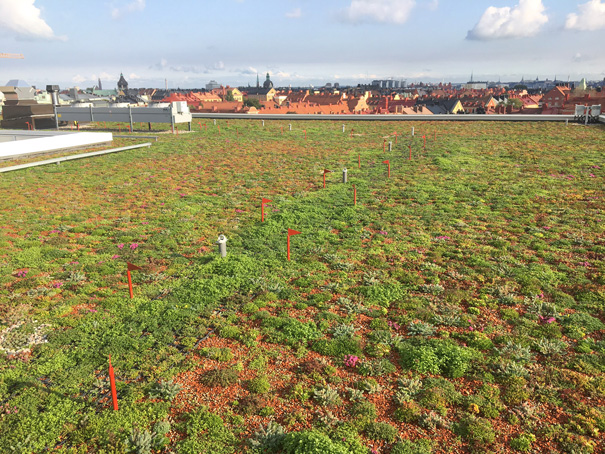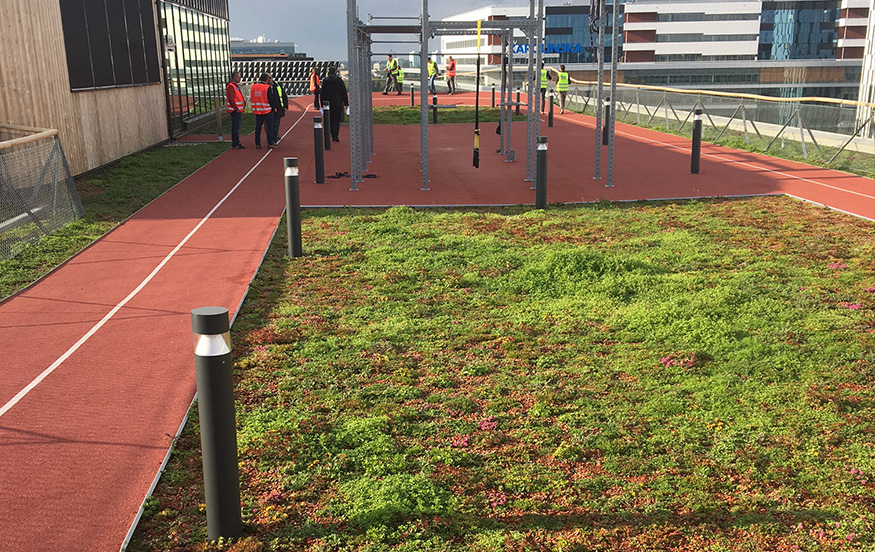The Mastic Asphalt Council (MAC) has recently become an associate member of the Green Roof Organisation (GRO), an independent trade association dedicated to supporting and developing the green roofing industry in the UK.
The Green Roof Organisation represents all elements of the green roof sector including manufacturers of waterproofing and green roofing products, suppliers of green roof systems and components, specialist contractors from the roofing and landscape sectors and associates including other trade associations, designers and architects.
The vision of the Green Roof Organisation is for every city and town in the UK to require high quality green roofs on new build flat roofs – whether for amenity, biodiversity gain, rainfall management or aesthetics. Another aim is to drive the retrofitting of green roofs to existing buildings where structurally possible.
The Green Roof Organisation was founded in 2009 as a Special Interest Group in response to the demand for UK relevant guidance for the increasing number of green roofs being specified in the UK. The GRO Green Roof Code of Best Practice for the UK was published in 2011. Significantly based on the German FLL guidelines, adapted to suit the UK market, the original ‘GRO Code’ gained widespread acceptance in the construction market, being used as a reference document by standards bodies, specifiers, manufacturers and contractors alike. The current edition of the ‘GRO Code’ was published in 2014 and was expanded to encompass further clarifications, more detailed installation information and to reflect changes within the industry. The Green Roof Organisation has recently completed its transition into a trade association.
In recent years, green roofs have risen in popularity and more and more architects and specifiers are embracing the concept of green roofs due to their ability to have a significant effect on a building’s sustainable credentials. Mastic asphalt is also being positively encouraged as an ideal solution for green roof and other waterproofing applications.
 The term ‘green roof’ refers to a roof that is partially or completely covered with vegetation and a growing medium, planted over a waterproof membrane. It may include additional elements such as root barriers, drainage or irrigation systems. Other features that can form green roofs include ‘container gardens’ where plants are maintained in pots, rooftop ponds and elevated open space areas that primarily form pedestrian routes on the roofs of lower level buildings.
The term ‘green roof’ refers to a roof that is partially or completely covered with vegetation and a growing medium, planted over a waterproof membrane. It may include additional elements such as root barriers, drainage or irrigation systems. Other features that can form green roofs include ‘container gardens’ where plants are maintained in pots, rooftop ponds and elevated open space areas that primarily form pedestrian routes on the roofs of lower level buildings.
The concept of green roofs has been around for some time, with the first green roofs appearing in northern Europe. Countries including Scandinavia, Germany, Austria and Switzerland have a long tradition of using green roofs. In some countries, legislation has been introduced to encourage the installation of green roofs, with many German cities for example providing incentives for green roof installation. Around 10% of all German roofs are now green and in France a law has been passed dictating that rooftops on new buildings built in commercial zones must either be partially covered in plants or solar panels. In addition, every new build in Stockholm must incorporate a green roof. Outside Europe, Canada, USA, Japan and Singapore have all experienced growth in green roofs.
In the UK, the City of London actively encourages the installation of green roofs for their environmental benefits. They enhance biodiversity, reduce rainwater run-off, improve insulation, moderate the local climate, make buildings more attractive and provide amenity for residents who may not have access to private gardens.
Within densely built-up areas such as the City of London, it is important that buildings are environmentally sustainable. With the close proximity of the River Thames, the abatement of flood risk is also a significant issue. Green roofs in the City of London minimise the urban heat island effect, whilst also providing rainwater run-off attenuation and reducing the risk of flood.
Whether intensive or extensive, biodiverse or brown, it is critical that green roofs are built on a solid waterproofing foundation. Offering exceptional durability and outstanding green credentials, mastic asphalt is an ideal choice for specifiers seeking an eco-friendly waterproofing solution for green roof specifications. Recognised for its environmental performance and aesthetic properties, a green roof system laid with a mastic asphalt waterproofing system enhances the environment, controls storm water run-off and reduces noise and heat transmissions by upgrading the acoustic and thermal performance of a roof.
In addition, when contractors use mastic asphalt for a green roof system, it eliminates the need for root barriers, which may well have been necessary had a substitute material been used. Alternative membranes to mastic asphalt can also be more prone to site damage leading to potentially catastrophic and expensive leaks. Mastic asphalt also offers a safe, flame-free application.
Mastic asphalt is carbon neutral and 10 years ago the mastic asphalt sector became the first industry in the world to achieve the CarbonZero standard. Mastic asphalt is 100% recyclable at the end of its useful life and it is able to be recycled and broken down into hardcore or used in roof screeds. Mastic asphalt can be specified on any green project, safe in the knowledge it will minimise the threat of climate change and be tough enough to take any green roof design.
With the future of roofing looking green, the reliability and integrity of mastic asphalt has seen more and more architects and designers specifying this waterproofing membrane for a wide range of green roof applications – from schools to hospitals, office buildings to apartment blocks – making it their preferred choice for biodiverse habits that will indeed benefit us all both now and in the future.
This article featured within the August edition of RCi Magazine – click here to view the full article.

